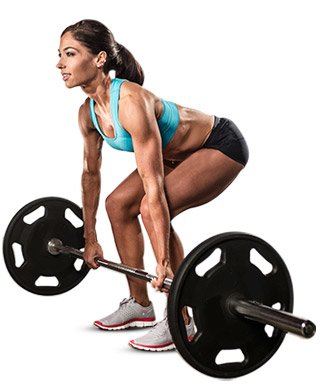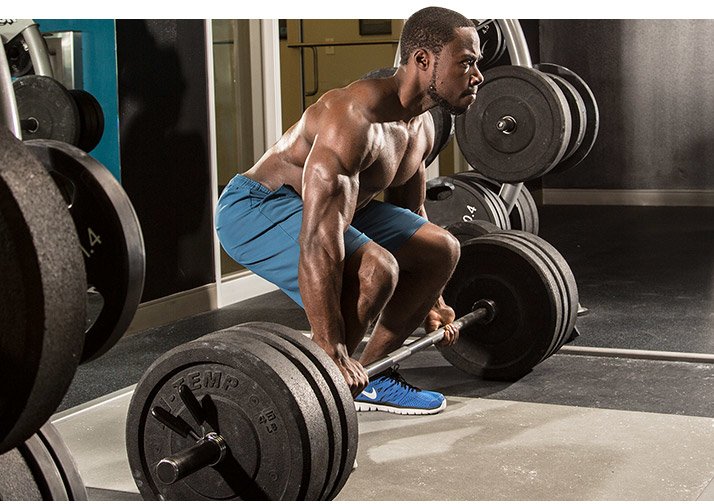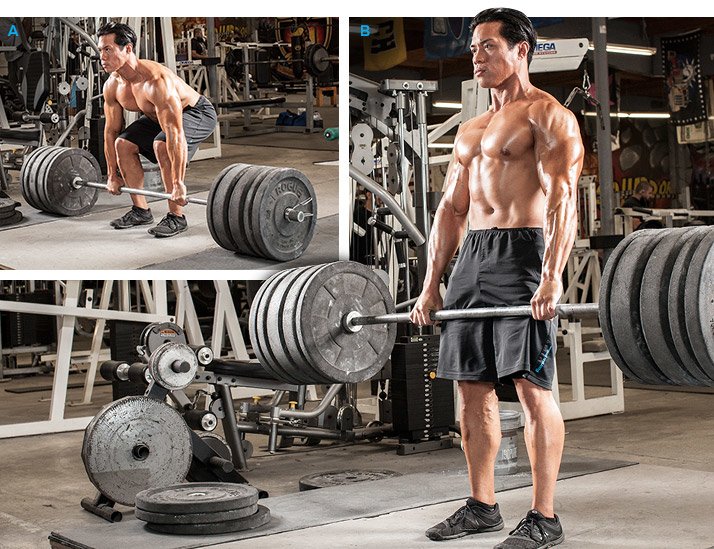The barbell deadlift is one of the best exercises around, period. Whether you want to build muscle, burn fat, increase athleticism, or focus purely on gaining strength, it's the one movement every lifter must do. But it only helps you out if you learn to do it right.
How To Deadlift
Look on YouTube and you'll find a whole bunch of folks doing their best one-humped camel impersonations while dragging a barbell up their legs. Yeah, don't do that. Every time you deadlift, you should be totally focused on good form.
Good form reduces injury risk. The risk is never zero, but good form distributes the lift's stress evenly across tissues rather than placing a destructive load on a specific area—the lower back, for example.
Secondary to limiting injury risk, good form also boosts performance: The right muscles work at the right times to crane the bar from the floor to the lockout position. When you lift with good form, the bar follows a path that allows for efficient use of the legs, hips, and back.
Start With The Hip Hinge
Now, you're probably eager to practice in the gym, but hang on a moment. I often work with lifters who want to rocket headfirst into a movement, when in reality it's important to pump the breaks and master the basics first.
The standard deadlift is a heavily loaded version of the hip hinge, which is a basic human movement pattern.
The hip hinge is exactly what it sounds like: hinging at the hips. It's not sitting down, but more like sitting back. This is one of the main things that makes it different from a squat.
The movement comes from your hips, not your knees. It's like a horizontal thrust: your butt goes back as you sit back, then you fire your glutes forward as you stand up.
Butt to Wall with PVC Watch The Video - 00:26
When you do a good hip hinge, you keep a neutral spine while loading the hips and posterior chain, or the muscles along the backside. To try hinging, stand near a wall facing out, softly bend at the knees, keep an arch in your lower back, and sit back by hinging at the hips until your butt touches the wall. Voila! You've hinged.
Learning to hinge before stepping up to a barbell helps you lift safer and stronger, so learn to hinge well before you deadlift! For an even more detailed guide, check out my article, "How to Hip Hinge for Ultimate Performance."
Proper Form For The Deadlift
Once you've mastered the hip hinge, you're ready to work toward the main event. What does good deadlift form look like?

- Your feet should be spaced hip-width apart with your grip just outside your legs.
- Use an overhand grip.
- Your back should be flat—neutral spine—from start to finish.
- Your shoulders should be back and down.
- The bar should remain in contact with your legs for the entire range of motion.
- Your hips and knees should move together to transfer the bar from the ground to an upper-thigh, locked position.3
If you can't keep a flat back when setting up to deadlift from the floor, don't lift from the floor! There's no rule that says you have to.
Elevate the bar on squat-rack pins or jerk boxes to a position in which you can flatten your spine. This great deadlift variation is called a "rack pull," and it's especially good for those with mobility issues that limit their range of motion.
Since many beginners have mobility issues, like tight hamstrings, I recommend you start with the rack pull and gradually progress to the full-range pull.
How To Progress Safely
How do you know if a weight's too heavy? For a beginner, the answer is simple: it's too heavy when your form breaks down. If your spine rounds or your hips and knees don't move together, the weight is probably too heavy.
The safest way to progress in weight is to hire a qualified coach to write your program and cue your lifts. If that's not in the cards, it's best to simply add 5-10 pounds to the bar each week. It sounds slow and boring, but you'll get a lot of practice while earning the ability to lift heavy.
Why Deadlift?
So, why bother to learn to deadlift? Quite simply, it's one of the most effective exercises for developing the pure strength that leads to bodily size and athleticism. Since it's a full-body movement that uses a lot of muscle mass, the deadlift also builds total-body muscle.1
It's one of the few lifts that directly targets the hamstrings, a group of muscles often overlooked in the weight room.2 It also works your glutes, lats (upper back), and core.
This magic lift also improves posture. We live most of our lives focusing on the front of our bodies, ignoring our rears. In turn, we develop bodily frames without balance, leading to a host of postural issues—hunched shoulders and weak backs, for example.
Deadlifting reintroduces us to our body's backside—the hamstrings, glutes, and back. Posterior training balances the body, helping us stand taller and with greater strength.
In short, deadlifting will build muscle, improve your posture, give you balanced, full-body strength, and turn you into a total gym badass. After all, there's nothing quite like ripping heavy weight from the ground.

How To Fit Deadlifts Into Your Workout
Deadlifting makes the body pay a heavy tax—the nervous system and the musculoskeletal system both work hard. Since it can drain the nervous system, it's best for a beginner to train it at the beginning of a workout.
A fresh nervous system means productive reps, because the body more efficiently learns movement and you'll have better form. It's also safer. As you get tired, your form gets worse and injury is more likely. It's best to plan deadlift training for the time period right after your warm-up.
Don't think of this workout like you would a traditional body part, like back or chest. Instead, you'll work a number of important assistance exercises with it.
When you do a deadlift workout, beware of training any of the same muscle groups the day before or the day after. Proper recovery allows for gains in both strength and size.
One exception is when training for a powerlifting competition. The deadlift is the last event at a powerlifting meet, meaning that a lifter has already done three maximum squat and bench-press attempts before mounting the platform for a first deadlift attempt. You're going to be tired. In a powerlifter's case, training the deadlift last makes sense. But it's the only time you need to.
How Many Deadlift Sets And Reps To Do
Shoot for the 1-6 rep range. Creep above 6 reps and you invite the Bad News Bears to your training party. Fatigue wrecks your form, and a good lift becomes one rep away from a nagging injury. This lift is great for building strength, so keep it in the rep ranges that do so.
Keep the total reps of working sets under 30 and do fewer reps as you increase intensity. For example, include 4-5 working sets of 3-6 reps. Do a few easy warm-ups to work up to your first training weight. Then, you can either keep adding weight for each set, or keep the same weight for all your sets.
Training intensity, or the weight you use relative to your max strength for one rep on the lift, depends on skill. This is why it's good to know your one-rep max, or 1RM.
Advanced lifters max out their deadlift (lifting at 90-100 percent of 1RM) at regular, but not frequent, intervals. Newbies, however, should keep the intensity of their workouts low to moderate: around 50-60 percent of 1RM.
As you get more skilled, you'll add more plates to the bar, but at the beginning, keep the reps pretty light and crisp. No grinding, and no form breakdown.
How To Superset Deadlifts
Since this is a stressful lift, don't pair it in an aggressive superset, such as with another heavy lift. It pairs best with mobility and core drills that will improve your deadlift and train your strength without the strain of another heavy lift.
I like to pair mobility exercises that address the upper back, hips, and ankles, since the deadlift needs all of these joints to be flexible. Choose core exercises that fight spinal motion since they help to reinforce a neutral spine position.

Assistance exercises like these are designed to assist a lift's development. In our current case, assistance training is planned to train the posterior chain and core—the areas we've noted that improve performance.
These moves are grouped into different levels. The hardest ones immediately follow the deadlift, while second- and third-level lifts follow after. Here's a breakdown:
First-Level Assistance
- Rack pull
- Romanian deadlift
- Good morning
Second-Level Assistance
- Glute-ham raise
- Kettlebell swing
- Leg curl
Third-Level Assistance
- Barbell roll-out
- Pull-up
- Squatting exercises (focusing on hip extension)
Plan 3-5 sets of first-level assistance exercises in the 4-8 rep range, while secondary exercises should follow for 3-4 sets in the 5-10 rep range. Third-level assistance exercises can land in both rep ranges for 3 sets. They're "third level" because they don't help your deadlift directly, but they do train muscles that prepare the body to pull heavily.
Long Live The Deadlift
The deadlift is a powerful strength-training and muscle-building tool. It's a must-do for any training goal. Learn to hinge well, progress to the rack pull, and earn your way to the full-range move. When you get there, stick in the right rep ranges and plan your assistance exercises using the list. You'll pull successfully and enjoy a lengthy training career!
Ready to master the other "Big 3" moves? Check out these guides:
References
- Farley, K. (1995). Analysis of the conventional deadlift. Strength and Conditioning Journal, 17(6), 55-57.
- Wright, G. A., Delong, T. H., & Gehlsen, G. (1999). Electromyographic activity of the hamstrings during performance of the leg curl, stiff-leg deadlift, and back squat movements. The Journal of Strength and Conditioning Research,13(2), 168-174.
- Gotshalk, L. (1984). Sports Performance Series: Analysis of the deadlift. Strength and Conditioning Journal, 6(6), 4-9.

